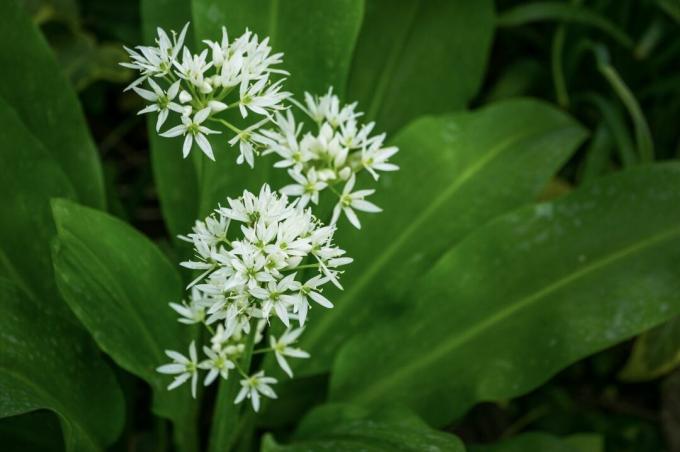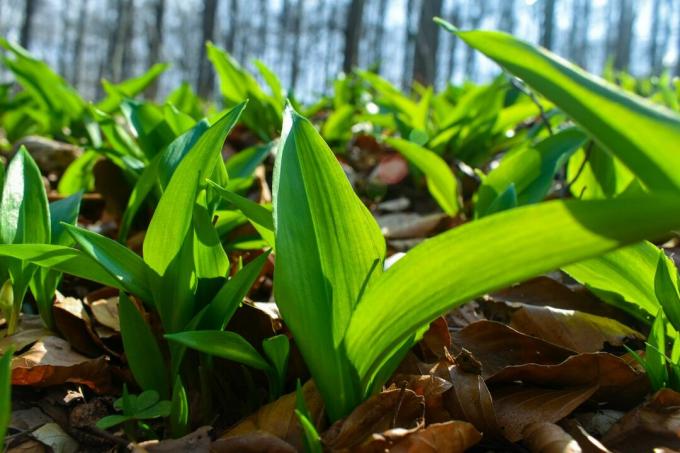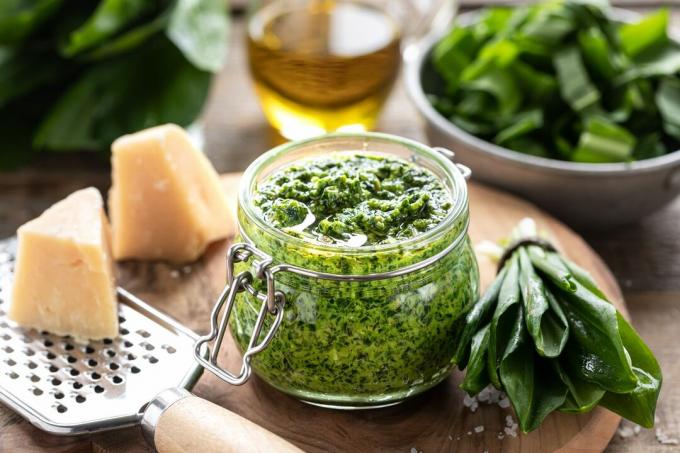Wild garlic is a close relative of garlic and onions. We will show you how and when you can plant, harvest and preserve wild garlic.

wild garlic (Allium ursinum) was not one of the typical garden vegetables for a long time. Today, however, it is enjoying increasing popularity again. Where the name of the spicy early bloomer comes from has not been finally clarified. Some claim that wild garlic was eaten by bears after long and barren winters due to its healthy ingredients and early growth. Others say it gives "bear powers" and has healing properties. Wild garlic is typically found in damp European alluvial forests. In this article you will find helpful tips and tricks on how to grow the aromatic herb in your garden at home.
contents
- Growing wild garlic: the right location
- Buy wild garlic plants or sow wild garlic?
- Grow wild garlic
- Harvest wild garlic
- Preserve wild garlic
- Collect wild garlic: look for your own seedlings in the forest
Growing wild garlic: the right location
Wild garlic prefers semi-shady places in damp alluvial forests or along streams. These location requirements should also be met in the home garden. In this case, partial shade does not mean that the wild garlic thrives best on the north side of a hedge or a house where there is shade all day. A place that receives only half-day sunlight, such as under large, free-standing trees, will suffice.

Wild garlic loves a nutrient-rich and humus-rich substrate. In your own garden it is sufficient to mix in compost or similar plant substrates when preparing the bed. You should make sure that the soil has a loose structure. Wild garlic prefers to grow in sandy-loamy locations. In order to simulate the conditions of a forest floor, leftover leaves can also be mixed in when planting wild garlic. An alkaline to neutral pH value in the soil is typical for alluvial forests. If necessary, you can add lime in your garden at home to raise the pH value. You should also keep the site slightly moist. In particularly dry locations, the wild garlic is happy about an occasional watering, but the soil should not be saturated by watering.

If you don't have your own garden, you can grow wild garlic plants in pots on the balcony. Here, too, attention should be paid to a semi-shady location, which can be used e.g. B. by placing the wild garlic next to a more vigorous plant. The conditions for the planting bed are very similar to those of growing in your own garden. However, the sole use of compost is sufficient here.
Buy wild garlic plants or sow wild garlic?
There are two ways to grow wild garlic in your home garden. On the one hand, seedlings can be bought, on the other hand, wild garlic seeds are commercially available. The potted plants are commercially available for 3 to 5 euros per pot, with a pot usually containing several plants. Seeds are much cheaper: 100 Buy wild garlic seeds are available from EUR 0.99 (plus shipping).

In the plant or The two cultivation methods differ only slightly, however. Both prefer the soil conditions described above. Only the sowing depth and the time of cultivation differ. If you decide to plant them, the usually young plants should be planted in March, as this is when the actual harvest time for the light green and juicy leaves takes place. To do this, the entire plant including the bulb should be removed from the pot and planted at a depth of 7 to 10 cm. A distance of 10 cm to the next plant is sufficient.
Wild garlic is a cold germinator. If you decide to sow wild garlic, you have to sow the seeds in autumn or stratify them in the freezer beforehand (activate germination). If you decide to sow the seeds directly, this should take place in autumn to guarantee the seeds enough ground frost. The placement depth should be 3 to 5 cm. Here, too, a distance of 10 cm to the next seed is sufficient.
Grow wild garlic
Wild garlic is a very robust wild species. After a few years, the plants should multiply themselves by scattering. After the wild garlic blooms in April, it begins to ripen and the leaves of the plant dry up. In late May to early June, the seeds are ripe and fall to the ground. Here they remain dormant until they are activated by the winter frosts, so that they can germinate again next spring.
Attention: It can happen that the seeds do not germinate until the second year after sowing because the conditions in winter were not suitable for interrupting dormancy.
Alternatively, the wild garlic can also be propagated using the onions. To do this, the wild garlic bulbs must be dug up and divided. The divided bulb is fully germinable and should be replanted elsewhere at a depth of 7 to 10 cm.
Notice: Leave some space for your wild garlic when multiplying, as the stock will become denser over time anyway.

A brief summary of the most important steps in propagation:
Propagation via seeds
- Seeds ripen in late May/early June
- Propagation by sowing (latest in autumn!) or self-scattering
- Dormancy is interrupted by frost in winter
- germination next spring
Propagation by Onions
- Dig up and divide the wild garlic onion
- dig in both halves again (7-10 cm placement depth)
- leave enough space to the neighboring plant
Harvest wild garlic
Wild garlic is an aromatic herb whose leaves offer a wide range of uses. The leaves are tastiest when they are young and juicy. The best time to harvest is mid-March. The leaves of the wild garlic are still slightly light green in color, are juicy and full of nutrients. The longer you wait, the more fibrous and darker the leaves will be. In April, the leaves may already have lost a large part of their aroma and developed a bitter taste, as the wild garlic is about to bloom. Before you harvest your wild garlic for the first time, you should wait for the first blossom to ensure the continued existence of the stock through self-sowing. In the following years, up to half of the wild garlic can be harvested to ensure stable propagation and maintenance of the plant population.

The cultivation of wild garlic at a glance:
- Find a suitable location
- Upgrade soil with substrate (possibly liming)
- loosen soil
- Sowing wild garlic (autumn) or planting wild garlic (in spring)
- Harvest wild garlic (mid-March)
Preserve wild garlic
Since the wild garlic can only be harvested in a relatively short time window, it is important to store it correctly. In the following we will explain how you can enjoy your tasty wild garlic long after it has been harvested:
- Store wild garlic fresh: Wild garlic can unfortunately only be kept fresh for a few days. To do this, it should be wrapped in a damp cloth or placed in a slightly damp freezer bag in the refrigerator.
- Dry wild garlic: You can also keep your self-harvested wild garlic dry, but the process of During drying, the characteristic aromas are lost and the valuable nutrients also evaporate Large part. We therefore advise against this method of storage.
- Freeze wild garlic: If you want to use your harvest longer, you should freeze the wild garlic. To do this, the leaves should be cut or chopped and placed in a freezer. The wild garlic can now be frozen directly. You can also pour water over the wild garlic and then freeze it to achieve better portioning.
- Process wild garlic: Another good way of preserving wild garlic is direct processing. This can come in the form of a tasty pesto or oil.

Collect wild garlic: look for your own seedlings in the forest
Instead of buying seedlings in stores, you can of course go out and collect wild wild garlic yourself. However, caution is advised here as the plants may be infected with fox tapeworms. It is therefore advisable to cook the wild garlic before consumption.

Picking wild garlic is not forbidden, but a decline in wild stocks can be observed. When collecting wild garlic, you should therefore proceed conscientiously in order not to overstrain the stocks. If you want to pick wild garlic, you are well advised to find out about the condition of the soil before you start looking. Particularly large amounts of wild garlic are to be expected in forests that grow on calcareous rock. You can hope for a good catch, especially at the foot of slopes, since larger amounts of lime are formed here water flowing down are accumulated and thus ensure a high pH value in the soil, which the wild garlic loves.
Wild garlic is easily combined with the poisonous lily of the valley or the autumn crocus confuse with. Here you will find 13 differences betweenn Wild garlic, lily of the valley and autumn crocusto avoid confusion.
